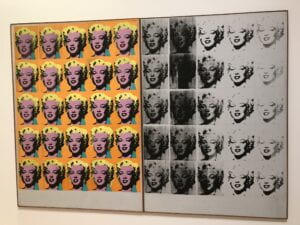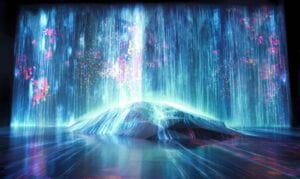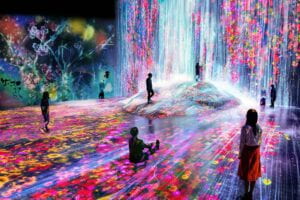Reading 3: New Media Art
When I hear the term “New Media Art,” I often think of visualization through technological media, such as digital art, video games, animation, and more. In today’s society, new media art is typically thought of as visually appealing art produced through technology. Not only that but new media art often includes an audience where they can interact with things such as manipulation of computer generation material, 3D printing, and robotics. It does not only include aesthetic visual art, but also real life things that can be touched, and used as means of innovation, like 3D printing to create objects designed on a computer, robotics for those with disabilities, construction, medical purposes, and more. Digital art today allows society to be more interconnected through means of media and kickstarts evolution and innovation in the world.
In comparison, in his book published nearly 25 years ago, Mark Tribe defines “New Media Art” as the use of emerging media technologies and implementing them into projects that possess themes and purposes concerned with politics, culture, and aesthetic value. He further discusses how there are two categories of Art and technology, and Media Art. Art and technology refer to art that includes the use of material technology, while media is purely based online. Both of these interconnected build the foundation of new media art. It was also developed to improve platforms of communication, publishing, commerce, and for personal uses. Throughout his introduction, Tribe refers to a variety of media, both historical and modern, to emphasize the importance of it as he highlights meanings, origins, and significance.
Since its original publication in 2006, Tribe’s idea of New Media Art is still true, yet slightly altered as New Media Art dominates today’s society. During the time it was published, technology existed, but for the main purposes of business, work, and communication. It was not as obtainable for each family, which meant most people lived without such technological materials. In today’s modern society, the internet and media control our lives. Nearly everyone has some type of mobile device or computer. Social media has become a widespread platform used throughout the world, not only for communication, but also for entertainment and much more. Technology is accessed every second of the day by people all over the world, and we are constantly glued to these devices. New media art now has even more innovations and evolved immensely as society is constantly developing more and more platforms for all types of uses.

Marilyn Diptych (1962) – Andy Warhol
Andy Warhol was an American visual artist, film director, and producer; his artworks significantly influenced today’s modern art as he led the Pop art movement.
Warhol silkscreened a single photograph of Marilyn Monroe 50 times using acrylic paint on a canvas. The silkscreen technique is also referred to as screen printing where a mesh screen is used to transfer an ink medium onto something else; essentially a large stencil. The significance behind the Marilyn Diptych was to illustrate the distinct contrast between her famous, glorious life, compared to her private life. Marilyn Monroe is often viewed as an inspirational figure of all time, although her personal life consisted of obstacles such as addiction and mood disorders. He used vivid colors for the first 25 images to display her fame and livelihood, while the other 25 were in grayscale of black and white to depict her sufferings with personal life. Each image is slightly distinguishable from the next as they all vary in highlighting or shadowing different features of her face.


Universe of Water Particles on a Rock where People Gather (2018) – teamLab
Established in 2001, teamLab is an international art collective navigating through art, science, technology, and the natural world combined. The team includes specialists, artists, programmers, engineers, CG animators, mathematicians, and architects. Their purpose is to explore the relationship between self and the world, as well as various forms of perception. They have numerous exhibitions held worldwide in famous cities, as well as permanent exhibitions (teamLab Borderless & Planets in Tokyo, teamlab Borderless Shanghai, teamlab SuperNature Macao).
This teamLab Borderless project is essentially a digital art museum made possible with interactive digital installation. The artworks all connect into a borderless world where they move out of rooms, communicate, intermingle, and influence each other. Visitors immerse themselves in this unique experience as they explore and wander into an unmapped world of new media art. The museum space is a three-dimensional 10,000 square meter area, and was located in Aomi Station, Odaiba, Tokyo. Water is stimulated to fall onto the rock, where the water flow then creates the waterfall shape. Numerous calculations were made in order to recreate the look of water in digital media: the use of numerous water particles, interaction between each other, and line drawn in relation to its behavior. The interaction aspect of it is that when visitors stand on the rock or touch the waterfall, they manipulate the movement of the water, and the flow transforms. The group of artworks within the area have the same concept of time as the human body, as its movement flows smoothly. The effect of this digital art world is that visitors are influenced to form connections and relationships with others, which also sparks their creativity. Through escaping reality and entering this closed yet completely borderless world, visitors are able to explore to their heart’s content and completely envelope the experience. This form of digital art is a great innovation to new media art itself, as it combines human experience and the real life world with art created through technology.
